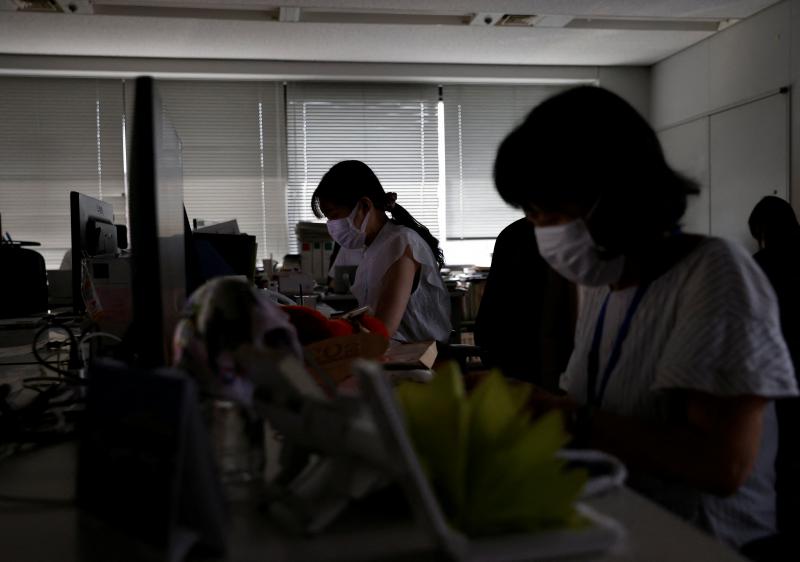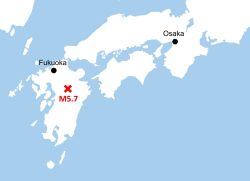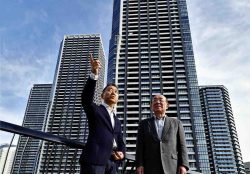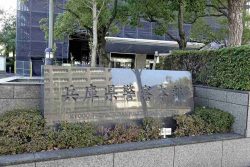
The interior of Ministry of Economy, Trade and Industry (METI) building is dimly lit to save electricity during daytime as Japanese government issues warning over possible power crunch in Tokyo, Japan June 27, 2022.
16:27 JST, June 29, 2022
Tokyo (Jiji Press)—The service area of Tokyo Electric Power Company Holdings Inc. is under the Japanese government’s tight power supply advisory for the third straight day on Wednesday, with the electricity reserve ratio in the area expected to hit the lowest level in the past three days.
The tightening of the power supply-demand balance comes as temperatures rose further mainly in the northern part of the Kanto eastern Japan region. Kanto makes up a large part of the TEPCO service area.
The industry ministry is calling on households and businesses to save as much electricity as possible, especially between 3 p.m. and 8 p.m. (between 6 a.m. and 11 a.m. GMT), when the balance is seen becoming very tight, while taking precautions against heatstroke.
As of 10:10 a.m., the power reserve ratio in the TEPCO area was expected to decline to as low as 2.6 pct between 4:30 p.m. and 5 p.m. Wednesday. A ratio of 3 pct or higher is believed to be needed for stable power supply.
TEPCO is taking measures such as receiving electricity supplies from other power companies in an effort to ensure stable power supply in its service area, which includes Tokyo. The government plans to change the tight power supply advisory to a warning if TEPCO’s supply capacity falls in case of an unexpected event, urging TEPCO customers to further step up power-saving.
The company’s supply capacity fell below the earlier estimated level because the planned restart of the 600,000-kilowatt No. 5 unit at the Anegasaki thermal power plant in the city of Ichihara, Chiba Prefecture, east of Tokyo, was postponed from Wednesday to Thursday. The plant is operated by Jera Co., a joint venture between TEPCO and Chubu Electric Power Co. .
According to the Japan Meteorological Agency, the maximum temperature hit 40.0 degrees Celsius in the city of Isesaki, Gunma Prefecture, part of the Kanto region, at 2:18 p.m. Wednesday.
By 1:30 p.m., the mercury reached as high as 39.2 degrees in the town of Hatoyama in neighboring Saitama Prefecture, also in Kanto, and 38.5 degrees each in the Gunma capital of Maebashi and the city of Otsuki, Yamanashi Prefecture, central Japan.
In central Tokyo, the temperature rose to as high as 35.4 degrees by 1:30 p.m., marking the fifth straight day of an “extremely hot” day, when temperatures rise to 35 degrees or higher.
The maximum temperature hit 37.0 degrees in Nagoya, the capital of Aichi Prefecture, central Japan, recording an extremely hot day for three days in a row.
A heatstroke alert was issued for many prefectures between Ibaraki, part of Kanto, and Okinawa, southernmost Japan.
The meteorological agency also said that this year’s rainy season appears to have ended in the southern part of the Tohoku northeastern region, where it started on June 15, marking the earliest finish of the wet season there.
The previous record for southern Tohoku was marked in 1978, when the rainy season ended on July 5. The region saw this year’s rainy season end 25 days earlier than an average year and 17 days earlier than last year.
In the country, this year’s rainy season has ended in all regions except the northern part of Tohoku.
"Society" POPULAR ARTICLE
-

M4.9 Earthquake Hits Tokyo, Neighboring Prefectures
-

M7.5 Earthquake Hits Northern Japan; Tsunami Waves Observed in Hokkaido, Aomori and Iwate Prefectures
-

Israeli Tourists Refused Accommodation at Hotel in Japan’s Nagano Pref., Prompting Protest by Israeli Embassy and Probe by Prefecture
-

Tsukiji Market Urges Tourists to Avoid Visiting in Year-End
-

M5.7 Earthquake Hits Japan’s Kumamoto Pref., Measuring Upper 5 Intensity, No Tsunami Expected
JN ACCESS RANKING
-

Keidanren Chairman Yoshinobu Tsutsui Visits Kashiwazaki-Kariwa Nuclear Power Plant; Inspects New Emergency Safety System
-

Imports of Rare Earths from China Facing Delays, May Be Caused by Deterioration of Japan-China Relations
-

University of Tokyo Professor Discusses Japanese Economic Security in Interview Ahead of Forum
-

Japan Pulls out of Vietnam Nuclear Project, Complicating Hanoi’s Power Plans
-

Govt Aims to Expand NISA Program Lineup, Abolish Age Restriction



















